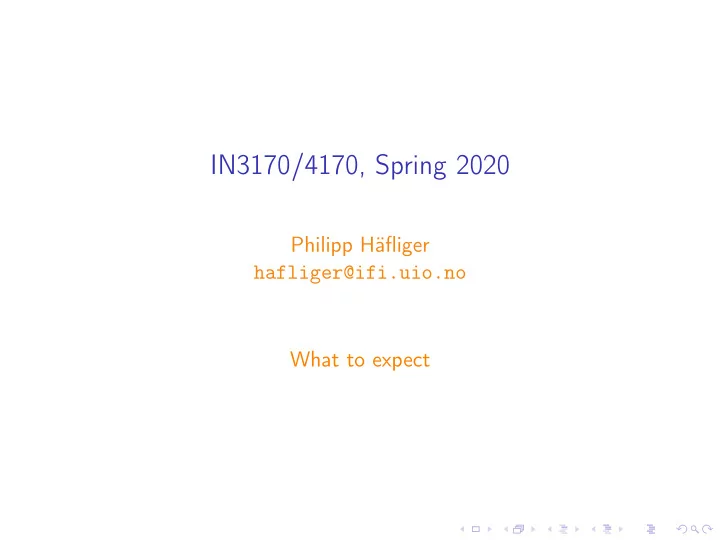

IN3170/4170, Spring 2020 Philipp Häfliger hafliger@ifi.uio.no What to expect
Content Why Application Specific Integrated Circuits? Why Transistor Level Digital? Why Analog? Course Goal Course Organization
Content Why Application Specific Integrated Circuits? Why Transistor Level Digital? Why Analog? Course Goal Course Organization
Why do an ASIC?
Why do an ASIC? Well, why not?
Why do an ASIC? Well, why not? ◮ Costly (development, design iteration time, production) ◮ Inflexible and low level of reusability
Why do an ASIC? Well, why not? ◮ Costly (development, design iteration time, production) ◮ Inflexible and low level of reusability Alternatives?
Why do an ASIC? Well, why not? ◮ Costly (development, design iteration time, production) ◮ Inflexible and low level of reusability Alternatives? ◮ Embedded Systems ◮ FPGA (pure digital) ◮ Microcontroller (digital, mixed signal)
Why do an ASIC? Well, why not? ◮ Costly (development, design iteration time, production) ◮ Inflexible and low level of reusability Alternatives? ◮ Embedded Systems ◮ FPGA (pure digital) ◮ Microcontroller (digital, mixed signal) So why bother?
Why do an ASIC? Well, why not? ◮ Costly (development, design iteration time, production) ◮ Inflexible and low level of reusability Alternatives? ◮ Embedded Systems ◮ FPGA (pure digital) ◮ Microcontroller (digital, mixed signal) So why bother? ◮ Ultimate performance (speed, power) ◮ Ultimate miniaturization ◮ Reliability (fewer points of failure) ◮ Very cheap for high volume production (e.g. CPUs) ◮ For (Mixed-Signal) Systems-on-Chip (SoC)
Content Why Application Specific Integrated Circuits? Why Transistor Level Digital? Why Analog? Course Goal Course Organization
Why do a Digital ASIC?
Why do a Digital ASIC? See previous arguments for and against ASIC The most important is the small price per piece for high volume production particularly for large scale systems-on-chip (SoC), e.g. CPU, but also FPGAs, GPUs, Microcontrollers etc. (mostly not ’full custom’ design but automated ’synthesis’), but real understanding on a single transistor level is required for the ultimate performance in speed, miniaturization, power consumption. Analogous in SW of where it’s worth to program in Assembler.
Content Why Application Specific Integrated Circuits? Why Transistor Level Digital? Why Analog? Course Goal Course Organization
The world is analog Analog electronics for sensor/actuator interfaces ⇔ ⇔ user ⇔
Ubiquitous Sensors Interfaces Trend to ‘Cyberphysical Systems’ Driven by Moore’s Law 1 1970 Computational Infrastructure • Stationary/backend • Wired • High end computing 1980 10 Mobile access devices • Human interaction • Portable 1980 • Mostly wireless • Battery 2000 >100 Sensory swarm • Miniature • Wireless • Autonomous/self-contained • Controlling and sensing 2010 natural processes Beyond Moore 5
Even Computers are Analog ;-) Where the digital abstraction breaks down • Gates • Increasing speed – Why this degradation? 100MHz – How do we improve performance? – Digital → analog 1GHz • Going for speed… • Noise/interference – Where does this noise originate? – How do we reduce this noise/interference? – Digital → analog • When scaling down size and scaling up complexity 10 TSL inf3410
Content Why Application Specific Integrated Circuits? Why Transistor Level Digital? Why Analog? Course Goal Course Organization
Course Goal (1/3) A) B) C V b2 A B V b3 Y V + V - A V out C V b1 B Understand these two circuits thoroughly!
Course Goal (1/3) A) B) C V b2 A B V b3 Y V + V - A V out C V b1 B Understand these two circuits thoroughly! Understand: analysis, properties, applications, limitations, tweaking, high level descriptions ...
Course Goal (2/3) And thereby understand the basic building blocks of analog and digital circuits: A) B) V + + A V out B Y V - - C Y = ¬ (( A ∧ B ) ∨ C ) V out = A ( V + − V − ) (1)
Course Goal (3/3) ... starting from modelling the basic active element of CMOS electronics, the field effect transistor (FET) nFET symbol Digital Abstractions Analog Linear Abstraction D D G D G G D D 0 if V > V 0 if V > V R= { R= { G switch G switch I=g (V -V ) m G S if V < V if V < V G G switch switch G G 0 if V > V R= { G switch if V < V G switch S S S S S
Content Why Application Specific Integrated Circuits? Why Transistor Level Digital? Why Analog? Course Goal Course Organization
Teaching 18 lectures (Mondays 10-12 in Shell), lecture foils, podcast (no guarantee!), book: ‘Microelectronic Circuits’ by Sedra & Smith, International (!) 7th Edition, selected papers Labs 3 tasks (counting 40% towards final mark, task 1 is only pass/not pass), lab assistant: Sebastian Wood, workgroups with up to 3 students Paper exercises exercises in preparation for exam (!), Tuesdays 14-16, teaching assistant: Zhijian Zhou Tools Cadence, matlab, solder iron/bread board, lab equipment Skills electronics, maths, physics, programming Exam written exam, counting 60% towards final mark, early in June
Recommend
More recommend